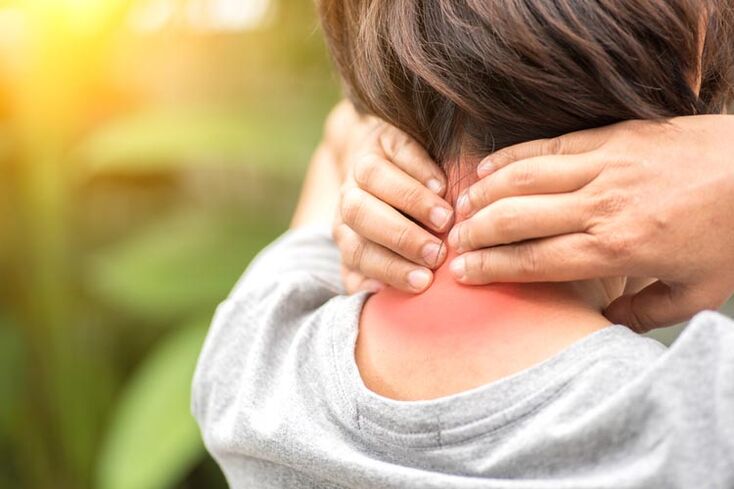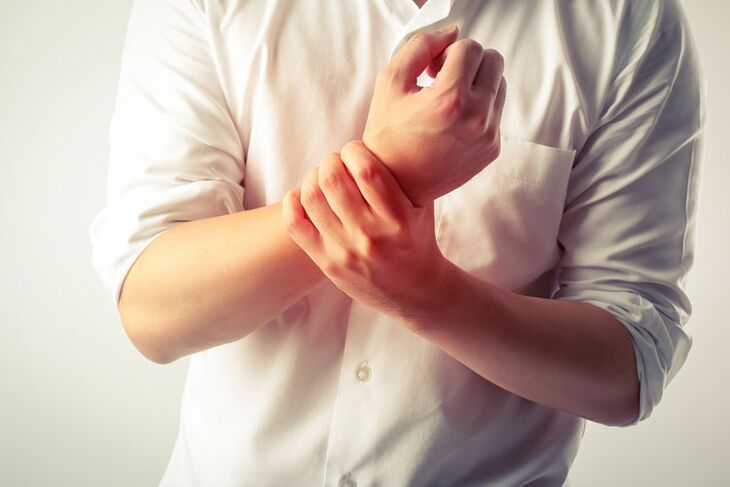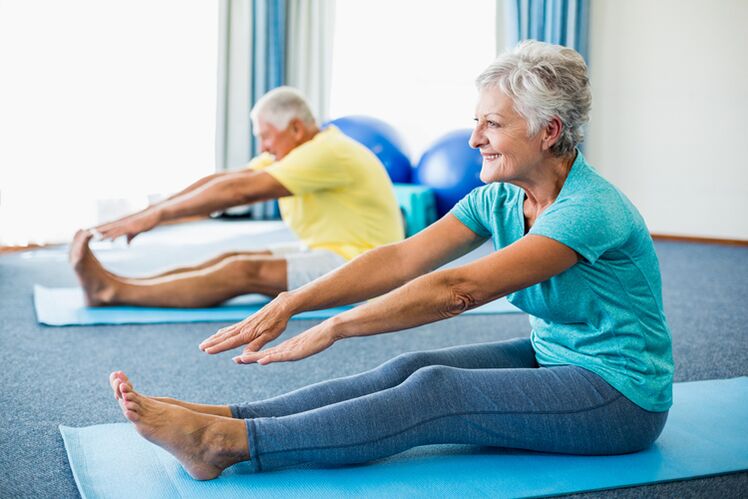
Osteochondrosis is a disease that is one of the most common in the world.Most people have osteochondrose of cervix in one or another after 35 years.Recently, there was a tendency to increase the number of people suffering from severe forms of diseases and to rejuvenate the disease, descending its lower age threshold.This is due to the fact that an increasing number of people around the world deals with sitting work and leads a sitting way of life.Meanwhile, the disease is quite dangerous, and each person needs to know what is - osteochondrosis, how it is manifested and how it is treated, be able to recognize its symptoms and start treating their symptoms and start treatment.
Cervical osteochondrose causes
Osteochondrosis is one of the few diseases that are characteristic only in humans.This disease does not happen in other animals.The reason for this is such a characteristic human characteristic as an upright walking.The vertical position of the spinal column leads to the fact that the vertebrae presses each other and the osteochondural tissue of the spine gradually degraded and becomes deformed.
The human spine begins from the cervical region.There are a total of seven vertebrates in this section - from the first to seventh.Vertebrae are separated from each other by intervertebral disks. The spine of the cervix is a particularly vulnerable part of it, which is primarily associated with increased mobility of vertebrae in this area.In the cervical region, the disease is reflected primarily in disks, which are a weak point in the structure of the spine.
The prevalence of cervical osteochondorosis also facilitates factors such as small spines and relative weakness of the neck muscles.Also, the development of cervical osteochondrosis is largely affected by insufficient blood supply to cartilage tissues.
Thus, the development of the disease is a complex and long-lasting process and there is no cause.Although the connection is established between the sitting work of the person and the presence of cervical osteochondrosis, the disease often occurs in trained people, especially athletes, due to the increased load on the maternity spine when raising the weight.
In older people, in a rule, degradation of rook structures is an inevitable process associated with the aging of the body and the weakening of its defense.However, the most common pathological type of cervical osteochondrone occurs, in which external or internal negative factors play a major role.
Factors that contribute to the development of osteochondrose doors:
- Bad posture
- Spine curvature
- Injuries backwards
- Overweight
- Hard physical work
- Sedentary work
- Sedentary lifestyle
- Metabolic disorders
- Frequent hypothermia
- Unpleasant position while sleeping
- Stress, overness
- Hereditary factors
- Contagious diseases
- Individual characteristics of body body, for example, neck that is too long or too short
Development of cervical osteochondorosis development
The disease has four phases.It is not always easy to determine the phase of the disease by analyzing symptoms, because sometimes the degree of degradation of osteohondural tissue cannot meet symptoms noticed in the patient.

First degree
Destructive processes begin in the osteochundural tissue of vertebrae.As a rule, at this stage of cervical osteochondrose, the symptoms are mild.Patients do not notice them at all or do not join the diseases of the spine, but attribute them to stress and overpaying them.
Second degree
The disk height begins decreases, and cracks appear on its surface.The symptoms of cervical osteochondrosis at this stage are manifested in constant pain, weaknesses and stiffness in certain areas of the person.
Third degree
The shape of a heavy disk, cervix and muscles are damaged.The patient experiences dizziness and pain in the back of his head.
Fourth degree
Osteophytes - growth of bone tissue that protects the vertebrae of stress, which leads to nerves.This leads to a stiffness of movement and damage to adjacent joints.
Cervical osteohondrose: Symptoms
Chief symptoms of osteochondrose cervix:
- The pain in the neck and shoulder
- Muscular weakness
- Increase sweating
- Hand hands
- Loss of coordination
- Dizziness
- Deterioration of vision and hearing
- Increased blood pressure
- Headache
These symptoms, typical of osteochondrose cervix, can be present at all stages of the disease.In most cases, only a few symptoms from the list were observed, and the rest can be absent.The person who encounters such signs of the disease is not always suspected of having cervical osteochondrose for the first time.Therefore, it can be addressed by various doctors - therapists, cardiologists, neurologists, surgeons.And as a result, the correct diagnosis can be made with significant delay.

Syndrome
With cervical osteochondrose, there are several syndrome, ie typical conditions that have a characteristic character complex.They manifest depending on which nerves and arteries have affected the disease:
- Spine syndrome artery
- Heart syndrome
- Hypertensive syndrome
- Radical syndrome
- cervical syndrome
The artery vertebrae syndrome is one of the more uncomfortable and more dangerous complications of cervical osteochondrose.It is caused by reduced blood flow through an artery that is done along the spine and delivers the brain.Syndrome is manifested in symptoms such as systemic or periodic dizziness, impaired hearing and vision.In some cases, disagreement may occur.The variation of syndrome is often observed, in which the blood flow in the artery is normal, but when the head turns in one direction or other, it can be descended abruptly.
Heart syndrome is developing when the roots of nerves that offer diaphragms or pectoral muscles.As a result, the patient can experience pain reminiscent of cardiagals, although there is no direct effect on the heart.However, syndrome can characterize such phenomena as tachycardia, hypotension and arrhythmia.
Hypertension syndrome is also one of the most dangerous complications.Unlike vertebrae syndrome, it is caused by the compression of veins, not arteries, which hinders the flow of blood from the head.Syndrome leads to an increase in intracranial pressure, which can manifest in symptoms such as nausea, vomiting and headaches.
Cervical syndrome is a little common in their etiology of classical migraine.It manifests in strong pain in the back of the head.The pain is paroxysmal, lasts up to ten hours and follows the vomiting.
Radicular syndrome is the most common syndrome in osteochondrose cervaries.Caused by compression of individual nerves in cervical vertebrates.It can be expressed in neck pain, rear of head, spatula, shoulders, stiffness and weakening of certain areas of weapons (to the inability to perform any manipulation) and neck.
Very often, several syndrome or individual symptoms are characterized by different syndrome.
As you can see, with osteochondrosis of cervix, the disease manifestations are multiple and patients are not always able to recognize the cause of their phenomenon properly.If you encounter similar symptoms, it is a reason for consulting with a doctor.
Diagnostics

In order to establish a diagnosis, it is recommended to consult a therapist.Will send experts - orthopedic, vertebrae, neurologist.
The following types of studies are used for the diagnosis:
- Radiography
- Computer Tomography
- Magnetic tomography
- Ultrasonic scanning of the neck vessels
The X-ray recording allows you to determine the displacement of the vertebrae, the presence of growth - osteophyte and salt deposits and disk compaction.Computer Tomography includes the creation of a range of X-rays that give a three-dimensional organ view, in this case cervix.Allows you to enter into detail the pathological process - the nature of the nervous compression, osteophyte structure, disk height, etc.Magnetic resonance, based on the physical performance of nuclear magnetic resonance, provides an even more detailed structural image of the spine.The ultrasound door door helps identify changes in blood flow in large door ships caused by disease.
Cervical osteochondrose treatment at home
How to treat osteochondrose of cervix at home and can be treated at all?To combat diseases, medicine has developed many methods.Some treatments can be used at home.But this process is a long and complete recovery is a little probable, especially in old age.However, it is possible to slow down and stop destructive processes in the spine at any stage of the disease.
At the initial phases of the disease, methods are usually conservative.Several methods are used to treat osteochondorosis of cervix:
- Medications
- Therapeutic exercise
- Physiotherapy
- Massage
- Special funds for attaching spine
If the disease has advanced in the last phase, and the severe destruction of the spine's osteohumban structure occurs, then the surgical intervention can be used to treat osteochondrose cervaries.
Drug
The following types of drugs are used:
- Chondroprotectors
- Vitamins
- Analgesics
- Counterparty medications
- Antispasmodics
In the case of an acute pain syndrome associated with osteochondrose, the first priority is its elimination.Oral medications are usually used, but if they are inefficient, an anesthetic blockade is used in difficult cases.
An antispasmodics are used for muscle cramps.Muscle relaxes show the highest efficiency in osteochondrose.Fats containing non-steroid medications can be used as anti-inflammatory and painkillers.
In the presence of the syndrome related to the injured circulation and blood supply - hypertensive and spinal arterial syndrome, drugs that mitigate the undesirable effects of these syndrome - feeding agents and nootropic medications.
Therapeutic exercise
Physical therapy is the simplest and most affordable type of treatment for cervical osteochondrose and, at the same time, quite effective.Physical therapy can also be done at home.With osteochondrose, exercise intensity does not play a decisive role;Only regularity is required.First of all, physical education is intended for strengthening the neck muscles that make up for the insufficient functionality of the spine and help him support weakened vertebrates.

Daily exercises recommended strengthen neck muscles.They can be very simple, which consist of turning and tilting the head in different directions or more more complex, including help the neck of the door.They can also be performed at home and at work.For example, if work is the seating, it is useful to do such exercises after an hour of sitting on a table or monitor.However, they can be performed only outside the period from deterioration and in the absence of pain.Otherwise, I can only worsen the condition.
Strengthening the shoulder muscle belt is no less efficient, for example, through regular exercise with light dumbbells.However, raising heavy objects (weights, piles) are contraindicated.Regular bath, which relieves stress on the spine, is also useful.
Physiotherapy
Physiotherapy is a method of treatment that uses certain physical fields and radiation to influence the body.Positive property of physiotherapy is to have a minimum number of contraindications.
The following methods of physiotherapy are used to treat osteochondrose:
- Ultrasonic exposure
- Laser therapy
- Influence of magnetic field
- Electric exposure (electrophoresis)
The magnetic field has a positive effect on the damaged body tissues and has an anti-inflammatory and analgesic effect.Ultrasound improves metabolic processes in tissues and relieves swelling.The same can be said about laser therapy.Electrophoresis is most commonly used in combination with medicines, as the use of electricity accelerates their body absorption.
Massage

Massage reduces the increased muscle tone, which causes spasm and reduces the flow of lymph, which causes swelling.The procedure helps improve blood circulation in the affected area, which stops the process of destroying interverters.
Other treatments
What to do with cervical osteochondrose if classic treatment methods do not help?To reduce the load on the neck, a special device is used - a collar with chess corrects the neck in a permanent normal position.It is recommended to carry during the exacerbation of pain or during extended sitting work.
To avoid deterioration, you should also organize a sleeping place.The pillow should not cause the door to curvature, and the mattress should be solid, and even.In some cases, special sleeping aids - orthopedic mattress and pillow - can help.
















